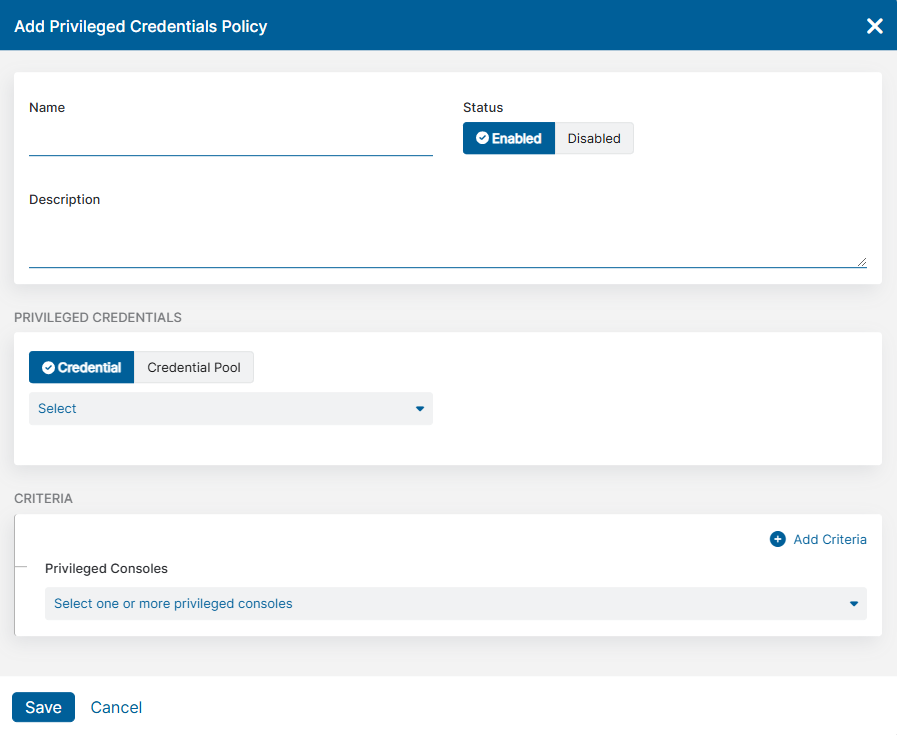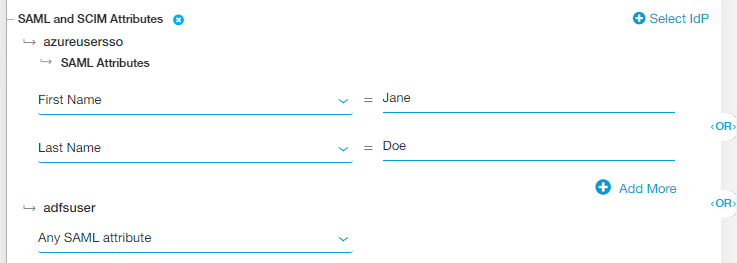Experience Center
Configuring Privileged Credentials Policies
After you create a privileged console and a privileged credential or a privileged credential pool that this policy rule applies to, you need to create a privileged credentials policy.
To configure a privileged credentials policy rule:
- Go to Policies > Access Control > Clientless > Privileged Policy.
- Click Privileged Credentials Policy.
- Click Add Rule.
The Add Privileged Credentials Policy window appears.
- In the Add Privileged Credentials Policy window:
- Name: Enter a privileged credentials policy name. The name cannot contain special characters, with the exception of periods (.), hyphens (-), and underscores ( _ ).
- Description: (Optional) Enter a description.
- For Privileged Credentials: Select if you want to assign a privileged credential or a privileged credential pool of multiple credentials for this policy.
- Credential: Select the privileged credential you want to use for this policy rule.
- Credential Pool: Select the privileged credential pool you want to use for this policy rule.
If you are within a Microtenant, you only see the privileged credentials that are created for the Microtenant.
- For Criteria, click Add Criteria to add any of the available criteria types. The drop-down menu only displays criteria that are not already in use by the rule.
- SAML and SCIM Attributes or Session and User Attributes
If you are subscribed to ZIdentity and have this feature enabled for your tenant, the SAML and SCIM Attributes criteria is replaced with User and Group Attributes. To learn more, see What Is ZIdentity?
- Click Select IdP and choose the identity provider (IdP) configuration you want to include in the policy rule. The IdP must be configured for User SSO. To learn more, see Configuring an IdP for Single Sign-On. If you need to include multiple IdPs in the policy rule, click Select IdP again.
- Click Select SAML and SCIM Criteria to add the criteria to which this rule applies:
- SAML Attributes or Session Attributes
By default, the policy rule for SAML Attributes is set to Any SAML attribute. You need to select specific SAML attributes.
If you keep the default Any SAML attribute option the privileged credential won't be applied to the related privileged console.
Choose a specific SAML attribute from the drop-down menu to apply the rule action to specific users, groups, departments, etc.:
- You can search for a specific attribute, select a listed attribute, or click Clear Selection to remove all selected attributes.
- After you make a selection, enter the SAML attribute value (i.e., the users to whom the rule applies) in the text field that appears.
- Click Add More to add multiple attributes, if necessary.
If you are subscribed to ZIdentity for users, the SAML Attributes option is replaced with Session Attributes. To learn more, see What Is ZIdentity?
Close - SCIM Attributes or User Attributes
Choose a specific SCIM attribute from the drop-down menu to apply the rule action to specific users, groups, departments, etc:
- You can search for a specific attribute, select a listed attribute, or click Clear Selection to remove all selected attributes.
- After you make a selection, enter the SCIM attribute value (i.e., the users to whom the rule applies) in the text field that appears.
- Click Add More to add multiple attributes, if necessary.
If you are subscribed to ZIdentity for users, the SCIM Attributes option is replaced with User Attributes. To learn more, see What Is ZIdentity?
Close - SCIM Groups
Choose a specific SCIM group from the drop-down menu to apply the rule action to a specific group:
- You can search for a specific group, select a listed group, or click Clear Selection to remove all selected groups.
- Click Add More to add multiple groups, if necessary.
These criteria appear under SAML and SCIM Attributes > <IdP Name>, where <IdP Name> is the name of the IdP configuration you selected in step a.
To process SAML and SCIM criteria in a rule, you must enable the SAML Attributes for Policy setting for SAML and the SCIM Attributes and Groups for Policy setting for SCIM when configuring an IdP. To learn more, see Configuring an IdP for Single Sign-On.
If you added multiple attributes or groups to the policy rule, then an OR Boolean operator is used between them by default. For example, if you selected FirstName and LastName, the policy rule is only applied to users with the specified FirstName OR LastName for that IdP. However, you can toggle this to an AND operator by clicking on it.
If the corresponding IdP setting (SAML Attributes for Policy) is disabled for SAML, but the policy rule has criteria for SAML attributes, then the rule is evaluated differently depending on the Boolean operator between the criteria:
- OR: The criteria evaluation is skipped for SAML attributes, but is continued for SCIM attributes and SCIM groups.
- AND: The policy rule is not evaluated. You must remove the criteria under SAML Attributes to process the policy rule.
If the corresponding IdP setting (SCIM Attributes and Groups for Policy) is disabled for SCIM, but the policy rule has criteria for SCIM attributes or SCIM groups, then the rule is evaluated differently depending on the Boolean operator between the criteria:
- OR: The criteria evaluation is skipped for SCIM attributes and SCIM groups, but is continued for SAML attributes.
- AND: The policy rule is not evaluated. You must remove the criteria for SCIM attributes and SCIM groups to process the policy rule.
If you selected multiple IdPs for the policy rule, then an OR Boolean operator is used between them by default. For example, you can select one IdP that includes FirstName OR LastName and another IdP that includes Any SAML Attribute. In this case, the policy rule applies to a user authenticating from the first IdP if they have the specified FirstName OR LastName or it applies to any user authenticating from the second IdP. However, you can toggle this to an AND operator by clicking on it.
If you use the Any SAML attribute option in your privileged credential, it won't be applied to the related privileged console.
If your IdP configuration for SSO includes SAML attributes or SCIM attributes from multiple IdPs, Zscaler recommends that you do not use the AND Boolean operator between policy rules.
Close
- Click Save.



